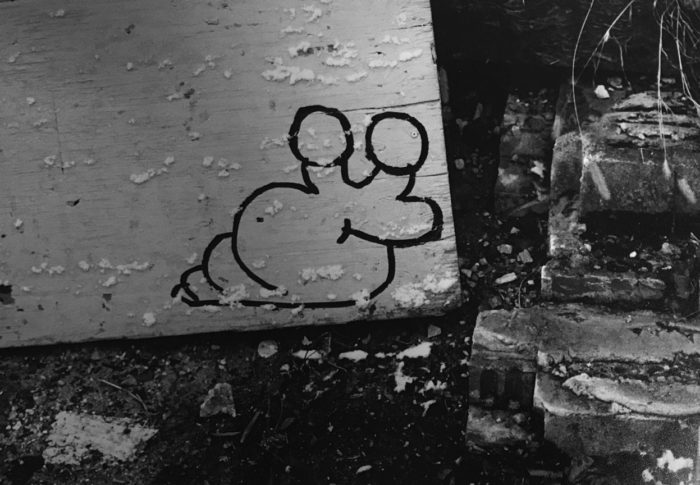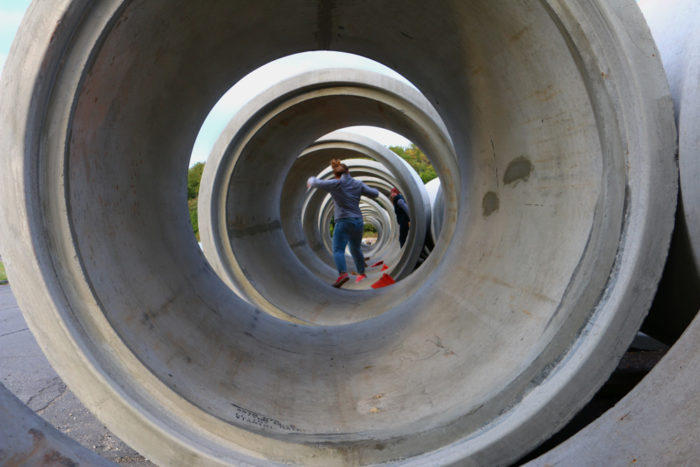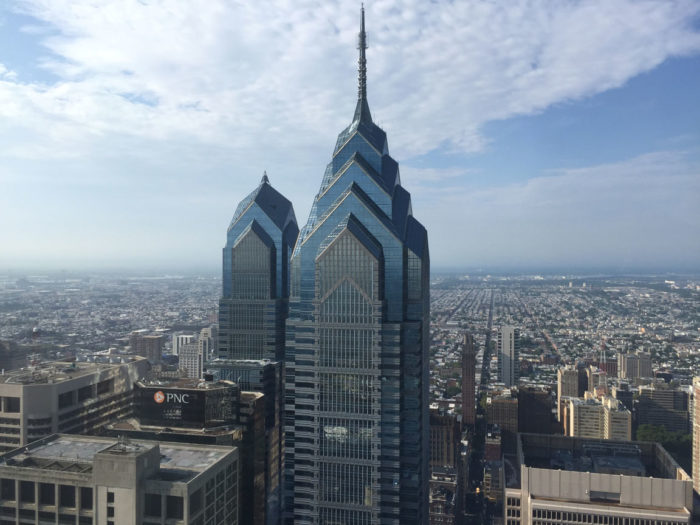A View of One’s Own: Student Photographs
A View of One’s Own: Student Photographs
This digital exhibition was inspired by the exhibition A View of One’s Own—Three Women Photographers in Rome: Esther Boise Van Deman, Georgina Masson, Jeannette Montgomery Barron and features works by Penn students from a range of disciplines and academic departments. They were asked to submit a photograph of Philadelphia or Penn, and to include an artist’s statement. Submissions were solicited by open call, and reviewed by an interdisciplinary committee. The digital exhibition found here represents their process of creative inquiry and exploration from Penn’s diverse student body. This is the second in a series of digital exhibitions organized by the Arthur Ross Gallery.

Lauren Altman · In Memory of Women’s Work
PENN DESIGN, MFA, ’18
This is a photograph I took with a 35mm camera. I then scanned the 35mm film in a Hassleblad film scanner to create the image. The photograph captures my reflection in the full-length mirror in my bedroom, facing the corner of 21st Street and South Street.
This photograph captures me wearing my mother’s work dress attire. She often wore skirt suits to her office where she worked as a worker’s compensation attorney. When I inherited her clothing, I became inspired to think critically about the history of women’s labor and the way social structure influences the garments women wear in their professions. Textile-making is traditionally a skill-set designated to women—craftspeople who are largely invisible in the consumer marketplace where we buy the garments we wear.
This photograph, taken in during the first year of my MFA at Penn, evokes my memory of seeing my mother leave for work daily in her suits, an image that has influenced my larger artistic inquiry into the history of women’s garments and the importance of making women’s work visible.

Sneha Easwaran · Film Noir
PENN DESIGN, LANDSCAPE ARCHITECTURE AND REGIONAL PLANNING, GRP ’17
Philadelphia has provided a sense of refuge that is engrained within the everyday landscape. It evokes a powerful vertigo that invites bodily movement in and around spaces. This visual speaks to me personally because it encapsulates a culmination of various spaces within the city that is juxtaposed within one another. As in the René Magritte painting L’Homme au Chapeau Melon suggests, “We exist, and then we don’t. The world will be there when we are gone. The dull factuality of physical things does not need human perception to make it persist.” Thinking about this through Magritte’s eyes becomes terrifying: that when you leave your home and lock your door all the objects in it still exist, unconscious as they are, without any need to be known, to be seen, by a conscious human. That’s one eerie way of looking at it. His art placidly and calmly asks terrifying questions about the solid things we take for granted.
The visual also presents itself as a conversation of intimacy. Intimacy comes in different forms in which one can relate the interior to the exterior environment. A sense of refuge in the image is defined by a house, one that derives the reserves and refinement of intimacy from winter, a season that has blanketed properties that envelops all form. Outside the house, snow covers all tracks, blurs the road, muffles every sound, and conceals all color. These factors increase the intimacy with increased intensity. All form breathes and geometry is transcended.

Ayodh Kamath · Crania Philadelphia
PENN DESIGN, ARCHITECTURE, PHD CANDIDATE, ’21
This image weaves cranial samples housed in the Penn Museum that were used for eugenic measurements by Samuel Morton in the mid-1800s with contemporary street photographs taken in “minority neighborhoods” in West Philadelphia, showing the lasting effects of racial theories from the past on the way this city is structured, inhabited and experienced today.
The exhibition at the Penn Museum displays replicas of Samuel Morton’s books on his findings titled “Crania Americana” and “Crania Aegyptiaca” which claimed to demonstrate the inferiority of non-white races. Morton’s work preceded by only a few decades the first wave of African Americans migrating into West Philadelphia from southern states after emancipation. West Philadelphia has subsequently become a home to minorities from across the globe: from Asia, Africa and Latin America, whereas white Americans moved to suburbs, such as Levittown. Conversely, today West Philadelphia is seeing gentrification fueled largely by the expansion of University City.
As an international student this photograph conveys my discomfort at the stark inequalities I see between the centuries of historic privilege in University City contrasted with the surrounding neighborhoods of minority residents. This image is part of my attempt to read my surroundings and understand them.
The people in the image appear to be doing ordinary, everyday things. Yet from the vantage point of University City, they appear alien, exotic. Their juxtaposition with Morton’s crania from the Penn Museum also critiques the practice of street photography as a voyeuristic and exploitative genre of photography drawing on notions of racism and the notion of “the other” inherent in the city.

Christopher Kao · Welcome to Penn by Drone
COMPUTER SCIENCE AND MARKETING, ’18
When I entered Penn as a freshman, our class photo was taken inside Franklin Field—this was before drones were a thing and the photographer would stand up on the highest stands, and try to yell down with instructions that couldn’t be heard. When I heard that the Class of 2020 NSO photo would be taken on Penn Park, I jumped at the opportunity to capture this Penn tradition with the backdrop of our beautiful city.
In this photo, I don’t just see 2,500 freshman. I see a class bound in unison, and blessed to be studying at such a fine institution, booming with construction in the background and beautiful parks in the foreground. Even the tiny speck in the background which has now become the Comcast Technology Center represents the innovation that has transformed our city. For a few brief seconds, all of the Class of 2020 has become frozen in a speck of time, united by a common goal to learn and explore, and standing in unison for what lies ahead.

Cari Krol · Untitled
PENN DESIGN, CITY PLANNING LANDSCAPE ARCHITECTURE AND REGIONAL PLANNING, ’19
This photograph is part of a series that explores ruins and expression in the West Poplar neighborhood to capture moments of spaces in flux. In these moments, a study of the intimacies of these spaces reveals remnants of human interaction within the urban fabric.
It is part of a series that explores resistance, emptiness, abandonment, self-expression, and development. It also demonstrates the tension and intersections between place, space, architecture, and humanity.
Like many of Philadelphia’s neighborhoods, West Poplar is in a state of redevelopment and inevitable gentrification. This photograph celebrates the expression of the neighborhood before external forces alter these spaces.

Dan Leapman · LIMN
PSYCHOLOGY, COGNITIVE NEUROSCIENCE, C’19
Coming from another city, I had the notion that Philadelphia was a cold, colorless place. Towering skyscrapers shadow the narrow streets. Bustling citizens and tireless car horns occupy every moment of potential silence.
Despite all that if you look in the right places the city both literally and figuratively shows its true colors. From the right angles, surrounded by the right people, the city’s vibrancy, diversity, and warmth seem to emanate.
Fortunately, it just requires a little investment and affection on your part.

Kaitlyn Levesque · Graffiti Pier
PENN DESIGN, MS HISTORIC PRESERVATION / MCP, ’19
I have grown into adulthood on the streets of Philadelphia. They are full of life and creativity. They are open, honest, and a little rough around the edges—I see myself in them. Since acquiring my first camera at the age of 17, I have been quietly and meticulously recording the mundane, looking for that elusive, decisive moment. I have little interest in constructed images; I much prefer to observe the world around me and to capture candid moments that represent sweet, seemingly inconsequential vignettes of life.

Andy Nguyen · Liberty in the Sky
COLLEGE OF ARTS AND SCIENCES, ’20
As I was eating lunch during my summer internship I found it surreal to glance out the window into the distance and see my life story unfold before me. From the elementary school I attended in South Philadelphia, to middle school in Southwest Philadelphia, to my high school in Northwest Philadelphia, and to my future university in West Philadelphia, I was right in the middle of it all when I was on the 43th floor of a center city skyscraper. This is where it all came together in my mind: my 18 years of hard work and determination had brought me to this height. It reminded me of Gatsby’s city, “a city seen for the first time, in its first wild promise of all the mystery and the beauty in the world.”
Fitzgerald, F. Scott. The Great Gatsby. Royston, Hertfordshire: Large Print hop, 2014. Print. 68.

Orchid Tierney · Spring Garden MFL, 06.04.2017
SCHOOL OF ARTS AND SCIENCES, ENGLISH, PHD CANDIDATE, ’19
What kind of temporal-spatial-rhetoric does a polaroid afford? How does its exposure agitate against the instantaneity of the film? While digital photography challenges the bond of the image, film also challenges the actuality of space and time by the relationship between chemical memory and the slow fossilization of an image.
This photograph of Philadelphia architecture and empty lots builds on my poetic engagement with the industrial and agricultural histories of the city as an enclave of agrarian modernity. Focusing on buildings and neighborhoods that have undergone reclamation, transformation, or erasure, I explore the variegated public spaces and contemporary architecture. This polaroid interrogates and evokes urban pastorals, such as cemeteries, empty lots, and train terminals.
The polaroid also implies exclusion. While digital photography permits the capture of a rapid succession of
images over a panorama, the polaroid is limited to a surface image of
In this photograph I use a Polaroid Sun 600 camera. Color variances are the result of the type and age of film. My choice of film is dependent on what is affordable and available. I prefer to use expired Polaroid 600 film although this product is increasingly difficult to find.

Liqiu Xu · LAYERING
PENN DESIGN, MLA, GFA ’17
When the city is covered in snow, all information on the ground is hidden while the vertical layers become clearer.
When we researchers try to read a city, we tend to read it in plans. We find every map in history to figure out the most important quality throughout the development of the city. We extract some elements of the modern city to provide a traffic map, restaurant guide, historical tour for daily use or entertainment. It seems that we see the world as a plane unless we have a purpose in our mind.
This project tries to bring the vertical layers of the city back to our minds. It has been a long time since the last time I slowed down my pace, wandered and enjoyed the combination of layered urban traces. There is no one in sight, which is an uncommon tranquil moment. The light of sunset gives this scene a warm and glossy finish.
Thanks To
Support for A View of One’s Own: Student Photographs is provided by the Hohns Family ESCAPE Program, the Provost’s Interdisciplinary Arts Fund, and the Philadelphia Cultural Fund.
The exhibition is made possible in part by Richard Baron and Adi Shamir Baron. Additional support for the exhibition is provided by the Arthur Ross Exhibition Fund, Mrs. Arthur Ross, the Patrons Circle of the Arthur Ross Gallery, Connelly Foundation, Dolfinger-McMahon Foundation, and the Pennsylvania Council on the Arts.